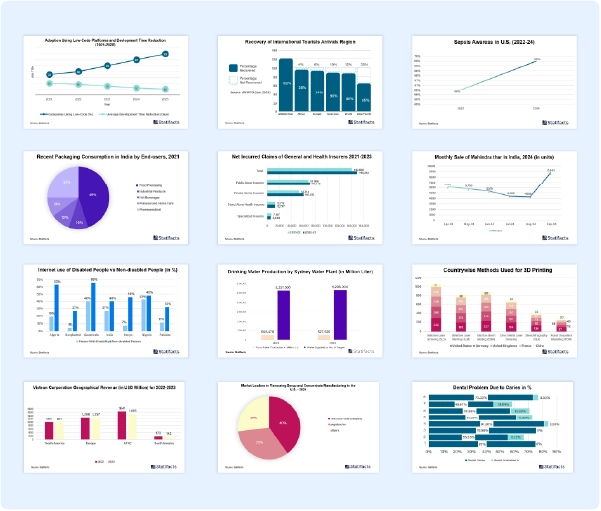The U.S. cell culture market size was exhibited at USD 6,119 million in 2024 and is projected to hit around USD 15,929 million by 2034, growing at a CAGR of 10.04% during the forecast period 2024 to 2034.
U.S. Cell Culture Market Report Highlights
- The market is segmented into consumables and instruments. The consumables segment held the market with the largest revenue share of 68.0% in 2024
- The instruments segment is expected to register at a significant CAGR over the forecast period.
- The biopharmaceutical production segment led the market with the largest revenue share of 35.9% in 2024 and is anticipated to grow at the fastest CAGR over the forecast period.
- The diagnostics segment is expected to grow at a significant CAGR over the forecast period.
The U.S. cell culture market refers to the production, distribution, and use of cell culture, which is the removal of cells from an animal or plant and their growth in a favorable artificial environment for several biotechnological and medical applications. Cell culture or tissue culture is the process by which cells are grown outside their natural environment under controlled conditions. The main uses of cell culture systems include biotechnology, genetic manipulation, pathological studies, studies of cell development and differentiation, study of physiological requirements for specific cell types, and experimental model systems in basic and medical sciences. A cell culture typically keeps the cells taken out of a source in an artificial environment alive.
The many benefits of cell culture in medicine help the U.S. cell culture market grow. The areas where the cell culture is used can be counted as the production of monoclonal antibodies, hormones, enzymes, interleukins, and some growth factors. Cell culture studies also serve many fields, such as the development of new drugs, toxicology studies, and cell or stem cell therapy methods. Cell cultures control the physicochemical environment, such as carbon dioxide tension, oxygen, osmotic pressure, temperature, and pH, which can be controlled very accurately, and physiological conditions, which can be constantly examined.
Traditional cell culture workflows require 24/7, hands-on processes that are time-consuming, prone to error, and hard to reproduce. Bringing in automation and AI can enhance every step of cell culturing, leading to faster and better decision-making and finally improving efficiency in research and drug development. AI takes on more creative and educational roles; traditionally, storytellers like playwrights, authors, and even teachers can find their roles changing or diminishing. AI and automation play a transformative role in revolutionizing laboratory research, mainly in cell culture. Using AI-based decision-making and automation, researchers can fully automate cell culture processes or adopt a co-piloted approach.
This standardizes procedures and also ensures reproducibility and consistency across 2D and 3D cell culture workflows. With the help of AI, researchers can create customized workflows that follow the natural flow of the cell culture process without the need for human intervention and modularization. Artificial intelligence (AI) based algorithms can trigger decision-making remotely, based on the algorithm training or parameters accepted by the scientists running the experiment. AI provides recommendations that are accepted or rejected by scientists remotely by reducing the need for a 24/7 hands-on process and freeing researchers from other tasks. These AI factors help the growth of the U.S. cell culture market.
Adoption of single-use technologies in cell culture offers benefits because they come pre-cleaned and pre-sterilized (generally through gamma radiation). Single-use technologies are solutions or products that are designed to be used only once and then disposed of. These are typically made from plastic materials like polyvinyl chloride, polycarbonate, polypropylene, and polyethylene. Single-use technologies include single-use bioreactors, which are efficient and safe in the production of monoclonal antibodies, recombinant proteins, vaccines, and cell and gene therapies that help the growth of the market. Single-use technologies offer cell culture conditions with less risk of contamination. Single-use systems have transformed the biopharmaceutical industry. Single-use advantages and innovations provide high efficiency over traditional systems. These innovations have transformed manufacturing processes by improving efficiency, contamination control, flexibility, and cost-effectiveness, which have helped the growth of the U.S. cell culture market. Single-use bioreactors have gained popularity worldwide.
Adoption and advancement in 3D cell culture technologies help the U.S. cell culture market grow. 3D cell culture can screen for small molecule drugs or be genetically manipulated to understand disease pathways. As compared to 2D cell cultures, 3D cell cultures more accurately predict the toxicity or efficacy of drug treatment. The main benefit of 3D cell culture includes more in vivo, such as cell interactions, cell division, and morphology, because 3D shapes more accurately mimic cells' natural environment. Recent innovations in cell culture methods have revolutionized in vitro culture tools for biomedical research by creating 3D models to recapitulate cell heterogeneity, structure, and functions of primary tissues.
Rising investment in stem cell research will help the U.S. cell culture market grow. Stem cell research plays an important role in treating a variety of conditions, including certain cancers, spinal cord injuries, and degenerative diseases. Cell culture techniques are important for studying and growing stem cells in laboratory environments. Private and government organizations are increasingly investing in stem cell research, which contributes to the growth of the U.S. cell culture market.

